The AMD Ryzen 5 2500X and Ryzen 3 2300X CPU Review
by Ian Cutress on February 11, 2019 11:45 AM ESTCPU Performance: Office Tests
The Office test suite is designed to focus around more industry standard tests that focus on office workflows, system meetings, some synthetics, but we also bundle compiler performance in with this section. For users that have to evaluate hardware in general, these are usually the benchmarks that most consider.
All of our benchmark results can also be found in our benchmark engine, Bench.
PCMark 10: Industry Standard System Profiler
Futuremark, now known as UL, has developed benchmarks that have become industry standards for around two decades. The latest complete system test suite is PCMark 10, upgrading over PCMark 8 with updated tests and more OpenCL invested into use cases such as video streaming.
PCMark splits its scores into about 14 different areas, including application startup, web, spreadsheets, photo editing, rendering, video conferencing, and physics. We post all of these numbers in our benchmark database, Bench, however the key metric for the review is the overall score.

PCMark likes a lot of single threaded performance, and the quad-core Core i3 matches the eight-thread AMD, with the quad-thread AMD just slightly behind.
Chromium Compile: Windows VC++ Compile of Chrome 56
A large number of AnandTech readers are software engineers, looking at how the hardware they use performs. While compiling a Linux kernel is ‘standard’ for the reviewers who often compile, our test is a little more varied – we are using the windows instructions to compile Chrome, specifically a Chrome 56 build from March 2017, as that was when we built the test. Google quite handily gives instructions on how to compile with Windows, along with a 400k file download for the repo.
In our test, using Google’s instructions, we use the MSVC compiler and ninja developer tools to manage the compile. As you may expect, the benchmark is variably threaded, with a mix of DRAM requirements that benefit from faster caches. Data procured in our test is the time taken for the compile, which we convert into compiles per day.
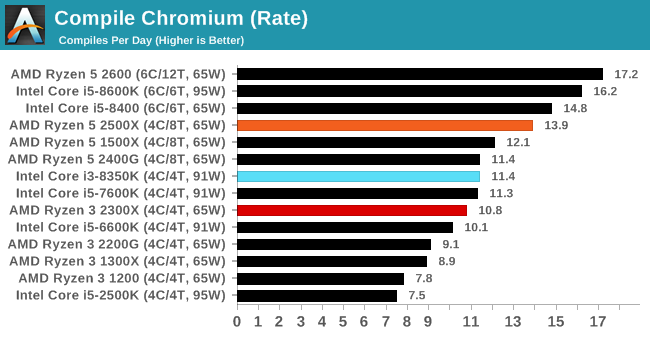
In our compile test, the higher thread count of the 2500X gives it a good lead over the other two comparison points, although the 2300X is only slightly behind the Core i3 here.
3DMark Physics: In-Game Physics Compute
Alongside PCMark is 3DMark, Futuremark’s (UL’s) gaming test suite. Each gaming tests consists of one or two GPU heavy scenes, along with a physics test that is indicative of when the test was written and the platform it is aimed at. The main overriding tests, in order of complexity, are Ice Storm, Cloud Gate, Sky Diver, Fire Strike, and Time Spy.
Some of the subtests offer variants, such as Ice Storm Unlimited, which is aimed at mobile platforms with an off-screen rendering, or Fire Strike Ultra which is aimed at high-end 4K systems with lots of the added features turned on. Time Spy also currently has an AVX-512 mode (which we may be using in the future).
For our tests, we report in Bench the results from every physics test, but for the sake of the review we keep it to the most demanding of each scene: Cloud Gate, Sky Diver, Fire Strike Ultra, and Time Spy.
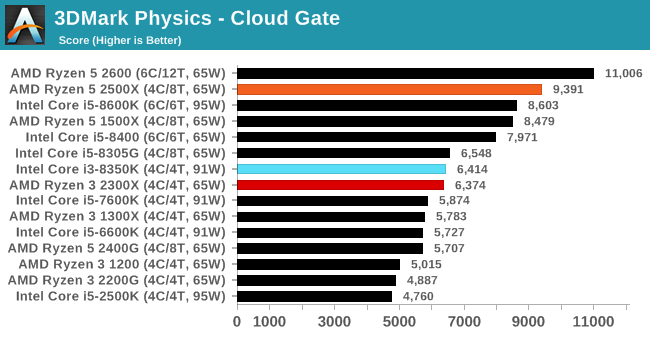
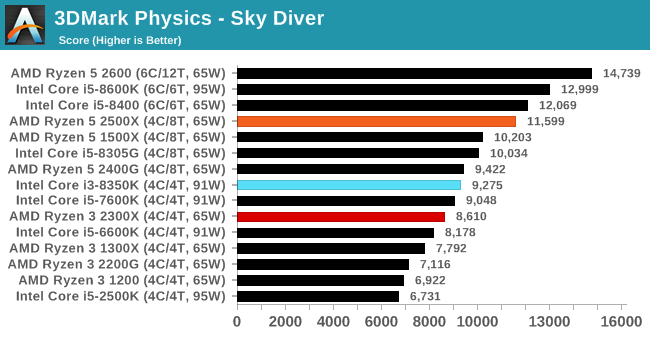
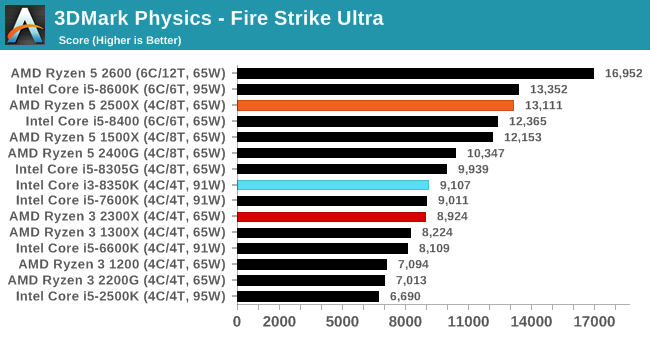
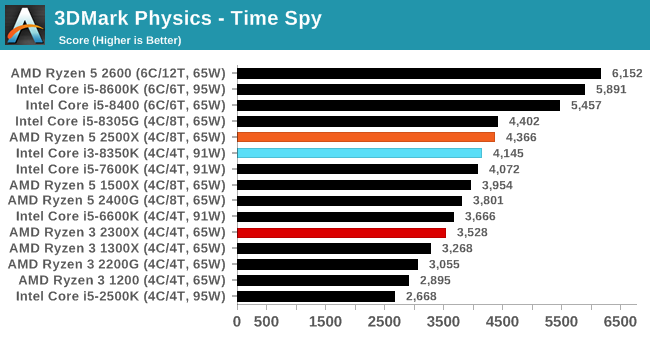
GeekBench4: Synthetics
A common tool for cross-platform testing between mobile, PC, and Mac, GeekBench 4 is an ultimate exercise in synthetic testing across a range of algorithms looking for peak throughput. Tests include encryption, compression, fast Fourier transform, memory operations, n-body physics, matrix operations, histogram manipulation, and HTML parsing.
I’m including this test due to popular demand, although the results do come across as overly synthetic, and a lot of users often put a lot of weight behind the test due to the fact that it is compiled across different platforms (although with different compilers).
We record the main subtest scores (Crypto, Integer, Floating Point, Memory) in our benchmark database, but for the review we post the overall single and multi-threaded results.
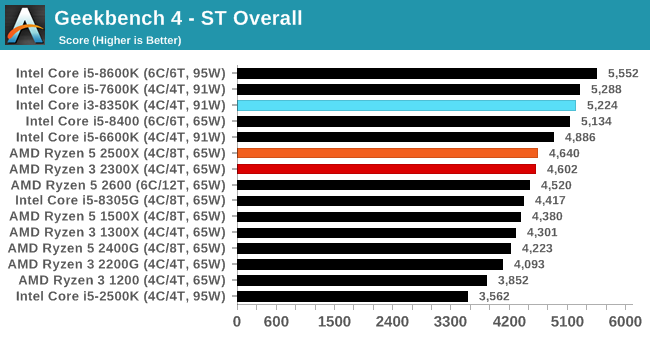
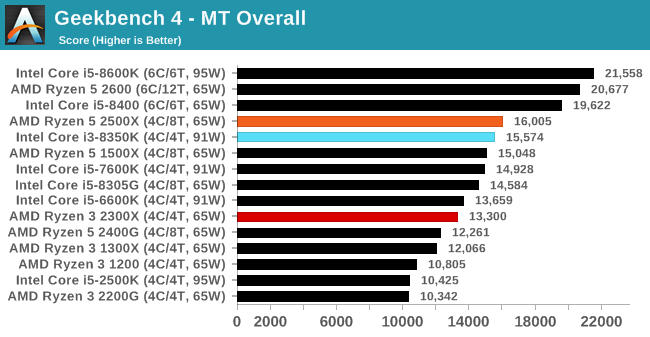










65 Comments
View All Comments
Smell This - Tuesday, February 12, 2019 - link
Thanks, Yall!"Where possible, we will extend out testing to include faster memory modules either at the same time as the review or a later date."
____ _____ _____ _____ _______
It would be sweet with some OC action, too.
Most impressive is the jump between the AMD Ryzen 2500X/1500X and Ryzen 3 2300X/1300X --- roughly 10% +/-. Good work, AMD.
I guess this is the difference between Zen and Zen+. With 7nm Zen ++ arriving soon, and Zen+++ next year, the CPU times they are a changin' ...
mr_yogi - Tuesday, February 12, 2019 - link
Love the inclusion of the i5 2500K, great job.Valantar - Tuesday, February 12, 2019 - link
These are both available from Norwegian retailers, though prices are ... not good. The 2500X costs as much as the 2600X, and the 2300X is barely cheaper than the 2600 (though admittedly the 2600 is _really_ cheap).urbanman2004 - Tuesday, February 12, 2019 - link
Reviewing CPU's that'll never reach the mainstream open market. Smart idea Anandtech 😉mikato - Thursday, April 4, 2019 - link
Are you saying it doesn't count if they are sold in prebuilt systems?tygrus - Tuesday, February 12, 2019 - link
AMD APUs (2400G & 2300G) try to keep atleast 50% of the power budget for GPU so the CPU load graph doesn't show the whole picture. It shows the power used for all chips for CPU load not CPU+GPU load. While having a mixture of CPU-only & CPU+GPU chips present means you want to focus on the CPU the reader needs to be reminded that the CPU+GPU load will be higher.I wish AMD had option for 95w TDP APU to compete with Intel models. With more CPU cores/headroom and 25% more GPU to use that 95w+ peak.
azrael- - Wednesday, February 13, 2019 - link
One reason to favor the 2300X and 2500X over the 'G' series CPUs is that Pinnacle Ridge supports ECC whereas Raven Ridge does not.Icehawk - Wednesday, February 13, 2019 - link
I'm begging here - can you please, please, please show us your config settings for the HEVC encoding? You get rates that are 6x+ faster than I can achieve - my O/C'd 8700k gets ~45fps with 1080 Fast 3500 settings using all else as default in Handbrake. I'd really love to hit the #s you get with just an i5. Help!Ian Cutress - Friday, February 15, 2019 - link
Check page 3?https://www.anandtech.com/show/13945/the-amd-ryzen...
xrror - Wednesday, February 13, 2019 - link
One additional savings for OEMs - they won't need to populate the motherboard components for integrated video on systems shipped with these.No need for displayport/HDMI/VGA connectors and associated filtering bits, so that saves a bit more on total BOM for the OEM.